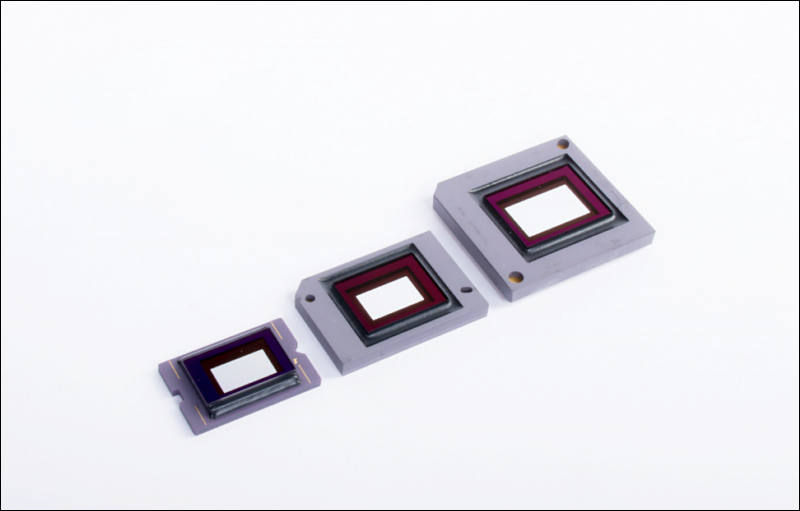
It allows to keep PV going, with more focus towards AI, but keeping be one of the few truly independent places.
-

Texas Instruments (TI) (NASDAQ: TXN) is pushing the boundaries of 4K ultra-high definition (UHD) technology with an expanded family of chipsets to bring 4K UHD technology to new applications. Building on the introduction of the DLP660TE chipset, the first affordable 4K UHD offering in the industry, the portfolio now includes two smaller chipsets, the DLP470TE and DLP470TP, to expand the sharp image capabilities of 4K UHD into a broader range of end equipment.
DLP470TP, DLP470TE & DLP660TE
Developers can now design DLP 4K UHD technology into a variety of end products such as laser TVs, mobile smart TVs, digital signage displays, smart home displays, pico projectors, business and education projectors, and more. The chipsets span a wide range of power, size, brightness and performance levels to help designers achieve any 4K UHD end-equipment objective. For more information about display offerings in TI's DLP Products portfolio, see http://www.ti.com/DLP4kExpansion-pr .
Each DLP 4K UHD chipset exceeds the Consumer Technology Association (CTA) definition for 4K UHD technology, displaying over 8 million pixels on the screen.
Key features and benefits of the chipsets
- The DLP470TP is the most compact 4K UHD solution from DLP Products, and is optimized for size and power. Measuring 17 mm by 24.5 mm and supporting brightness levels up to 1,500 lumens, the DLP470TP can deliver 4K UHD quality to equipment such as mobile smart TVs and pico projectors.
- The DLP470TE is optimized for projectors needing over 1,500 lumens. This chipset is in a larger package, 22 mm by 32 mm, which enables it to withstand the heat generated by brightness levels up to 4,000 lumens.
- The DLP660TE is the most powerful of the three 4K UHD chipsets. This digital micromirror device (DMD) is designed to enable projection applications up to 5,000 lumens.
TI collaborates with the most extensive ecosystem of optical engine manufacturers in the industry. This offers developers a path to production-ready optical engines, reducing design time and helping companies get their innovative products to market faster. To learn more, please visit the optical engine manufacturer page.
Availability
Developers can get started immediately with the DLP660TE which is available now in the TI store and through authorized distributors. The DLP470TE and DLP470TP will be in production in early 2018.

 sa897.jpg800 x 511 - 28K
sa897.jpg800 x 511 - 28K -
I want one!
-

Portable on table screen for such things, on sale today.
https://www.bhphotovideo.com/c/product/1202946-REG/grandview_pt_uw040vwm4b_u_work_32_x.html
For example can use small projector and such screen if you rarely need second 40" size monitor.

 sa901.jpg470 x 466 - 24K
sa901.jpg470 x 466 - 24K -
Is this real 4k? I mean real 3840x2160 ???
I am asking this because I read that the optoma UHD60 and UHD65 do not have all the 4k pixels:
"The Big 4K Question: The Optoma UHD65 uses the new 4K DLP chip which puts 3840x2160 discrete pixels on the screen. However the chip itself has 2716x1528 micro-mirrors and pixel-shifting technology is used to achieve the result on screen. The HUGE question is whether this method of achieving a 4K picture can match the image detail of fully native 4K chips."
http://www.projectorcentral.com/optoma-UHD60-uhd65-review.htm
-
-
2716 x 1528 = 4150048
3840 x 2160 = 8294400
1920 x 1080 = 2073600
the new chip is half the uhd pixels and twice the fullhd pixels.
It will be good image at a decent viewing distance.
-
The question is: why less pixels than uhd?
-
The question is: why less pixels than uhd?
Because it is micromechanical thing. Extremely hard (if possible at all) such things reliable for 4K.
-
I always thought DLP technology is the best. It has drawbacks ass all techs. But it's more accurate than other variants. Like LCD.
Is this new line will have increased price, or is more consumer low end oriented?
-
If the small chip DLP470TP can have 4 megapixels, so the larger chip DLP660TE could have 8 megapixels, because the micromechanical thing would be the same size.
They just could do a larger chip with 8,3 megapixels.
-
Things are not so simple.
I think that number of non defective 4K chips even with larger sizes will be not good.
Also, it is actually does not matter much. As mechanical chip shift does not differ from that micromirror+wheel combination are doing.
Howdy, Stranger!
It looks like you're new here. If you want to get involved, click one of these buttons!
Categories
- Topics List23,989
- Blog5,725
- General and News1,353
- Hacks and Patches1,152
- ↳ Top Settings33
- ↳ Beginners255
- ↳ Archives402
- ↳ Hacks News and Development56
- Cameras2,366
- ↳ Panasonic995
- ↳ Canon118
- ↳ Sony156
- ↳ Nikon96
- ↳ Pentax and Samsung70
- ↳ Olympus and Fujifilm100
- ↳ Compacts and Camcorders300
- ↳ Smartphones for video97
- ↳ Pro Video Cameras191
- ↳ BlackMagic and other raw cameras116
- Skill1,960
- ↳ Business and distribution66
- ↳ Preparation, scripts and legal38
- ↳ Art149
- ↳ Import, Convert, Exporting291
- ↳ Editors191
- ↳ Effects and stunts115
- ↳ Color grading197
- ↳ Sound and Music280
- ↳ Lighting96
- ↳ Software and storage tips266
- Gear5,420
- ↳ Filters, Adapters, Matte boxes344
- ↳ Lenses1,582
- ↳ Follow focus and gears93
- ↳ Sound499
- ↳ Lighting gear314
- ↳ Camera movement230
- ↳ Gimbals and copters302
- ↳ Rigs and related stuff273
- ↳ Power solutions83
- ↳ Monitors and viewfinders340
- ↳ Tripods and fluid heads139
- ↳ Storage286
- ↳ Computers and studio gear560
- ↳ VR and 3D248
- Showcase1,859
- Marketplace2,834
- Offtopic1,320






